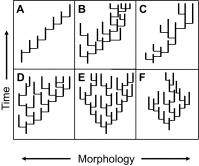Approaches to Macroevolution: 2. Sorting of Variation, Some Overarching Issues, and General Conclusions
- PMID: 29142334
- PMCID: PMC5661022
- DOI: 10.1007/s11692-017-9434-7
Approaches to Macroevolution: 2. Sorting of Variation, Some Overarching Issues, and General Conclusions
Abstract
Approaches to macroevolution require integration of its two fundamental components, within a hierarchical framework. Following a companion paper on the origin of variation, I here discuss sorting within an evolutionary hierarchy. Species sorting-sometimes termed species selection in the broad sense, meaning differential origination and extinction owing to intrinsic biological properties-can be split into strict-sense species selection, in which rate differentials are governed by emergent, species-level traits such as geographic range size, and effect macroevolution, in which rates are governed by organism-level traits such as body size; both processes can create hitchhiking effects, indirectly causing the proliferation or decline of other traits. Several methods can operationalize the concept of emergence, so that rigorous separation of these processes is increasingly feasible. A macroevolutionary tradeoff, underlain by the intrinsic traits that influence evolutionary dynamics, causes speciation and extinction rates to covary in many clades, resulting in evolutionary volatility of some clades and more subdued behavior of others; the few clades that break the tradeoff can achieve especially prolific diversification. In addition to intrinsic biological traits at multiple levels, extrinsic events can drive the waxing and waning of clades, and the interaction of traits and events are difficult but important to disentangle. Evolutionary trends can arise in many ways, and at any hierarchical level; descriptive models can be fitted to clade trajectories in phenotypic or functional spaces, but they may not be diagnostic regarding processes, and close attention must be paid to both leading and trailing edges of apparent trends. Biotic interactions can have negative or positive effects on taxonomic diversity within a clade, but cannot be readily extrapolated from the nature of such interactions at the organismic level. The relationships among macroevolutionary currencies through time (taxonomic richness, morphologic disparity, functional variety) are crucial for understanding the nature of evolutionary diversification. A novel approach to diversity-disparity analysis shows that taxonomic diversifications can lag behind, occur in concert with, or precede, increases in disparity. Some overarching issues relating to both the origin and sorting of clades and phenotypes include the macroevolutionary role of mass extinctions, the potential differences between plant and animal macroevolution, whether macroevolutionary processes have changed through geologic time, and the growing human impact on present-day macroevolution. Many challenges remain, but progress is being made on two of the key ones: (a) the integration of variation-generating mechanisms and the multilevel sorting processes that act on that variation, and (b) the integration of paleontological and neontological approaches to historical biology.
Keywords: Diversification; Evolutionary trends; Hierarchy; Mass extinction; Multilevel selection; Paleobiology; Radiation; Species selection; Species sorting.
Conflict of interest statement
The author declares that he has no conflict of interest.
Figures




Similar articles
-
Approaches to Macroevolution: 1. General Concepts and Origin of Variation.Evol Biol. 2017;44(4):427-450. doi: 10.1007/s11692-017-9420-0. Epub 2017 Jun 3. Evol Biol. 2017. PMID: 29142333 Free PMC article.
-
Developmental push or environmental pull? The causes of macroevolutionary dynamics.Hist Philos Life Sci. 2017 Oct 16;39(4):36. doi: 10.1007/s40656-017-0163-0. Hist Philos Life Sci. 2017. PMID: 29039031
-
Species selection and random drift in macroevolution.Evolution. 2016 Mar;70(3):513-25. doi: 10.1111/evo.12879. Epub 2016 Mar 4. Evolution. 2016. PMID: 26880617
-
Understanding processes at the origin of species flocks with a focus on the marine Antarctic fauna.Biol Rev Camb Philos Soc. 2018 Feb;93(1):481-504. doi: 10.1111/brv.12354. Epub 2017 Aug 10. Biol Rev Camb Philos Soc. 2018. PMID: 28799256 Review.
-
Biological hierarchies and the nature of extinction.Biol Rev Camb Philos Soc. 2018 May;93(2):811-826. doi: 10.1111/brv.12368. Epub 2017 Sep 24. Biol Rev Camb Philos Soc. 2018. PMID: 28944555 Review.
Cited by
-
Evolutionary legacies in contemporary tetrapod imperilment.Ecol Lett. 2021 Nov;24(11):2464-2476. doi: 10.1111/ele.13868. Epub 2021 Sep 12. Ecol Lett. 2021. PMID: 34510687 Free PMC article.
-
Approaches to Macroevolution: 1. General Concepts and Origin of Variation.Evol Biol. 2017;44(4):427-450. doi: 10.1007/s11692-017-9420-0. Epub 2017 Jun 3. Evol Biol. 2017. PMID: 29142333 Free PMC article.
-
Diversity, distribution and intrinsic extinction vulnerability of exploited marine bivalves.Nat Commun. 2023 Aug 15;14(1):4639. doi: 10.1038/s41467-023-40053-y. Nat Commun. 2023. PMID: 37582749 Free PMC article.
-
Topographically distinct adaptive landscapes for teeth, skeletons, and size explain the adaptive radiation of Carnivora (Mammalia).Evolution. 2022 Sep;76(9):2049-2066. doi: 10.1111/evo.14577. Epub 2022 Aug 2. Evolution. 2022. PMID: 35880607 Free PMC article.
-
The diffused evolutionary dynamics of morphological novelty.Proc Natl Acad Sci U S A. 2025 May 6;122(18):e2425573122. doi: 10.1073/pnas.2425573122. Epub 2025 May 1. Proc Natl Acad Sci U S A. 2025. PMID: 40310458
References
-
- Albert JS, Johnson DM, Knouft JH. Fossils provide better estimates of ancestral body size than do extant taxa in fishes. Acta Zoologica. 2009;9(Suppl. 1):357–384. doi: 10.1111/j.1463-6395.2008.00364.x. - DOI
-
- Alva DMCC, Diniz-Filho JAF, Villalobos F. Integrating selection, niche, and diversification into a hierarchical conceptual framework. Organisms Diversity & Evolution. 2017;17:1–10. doi: 10.1007/s13127-016-0299-x. - DOI
LinkOut - more resources
Full Text Sources
Other Literature Sources
